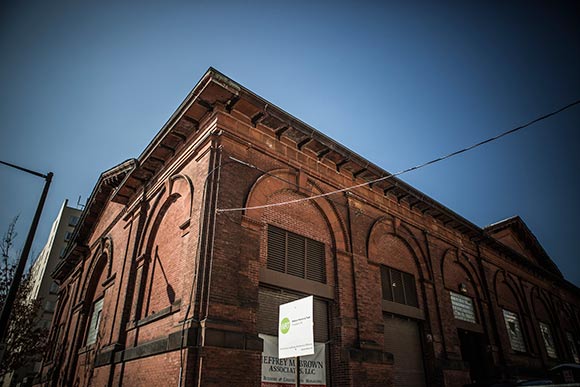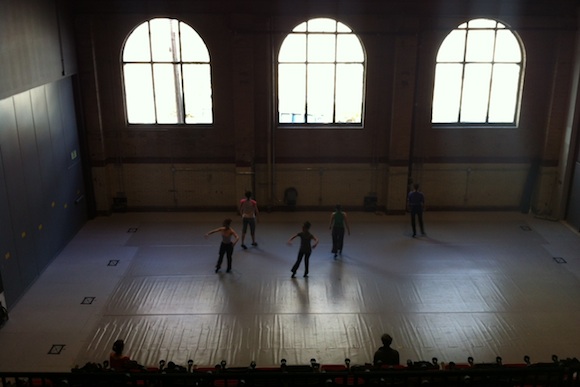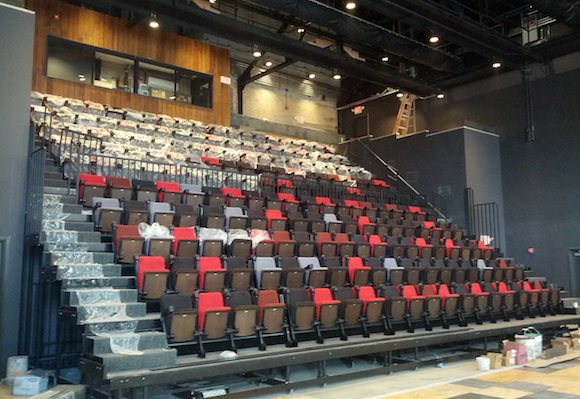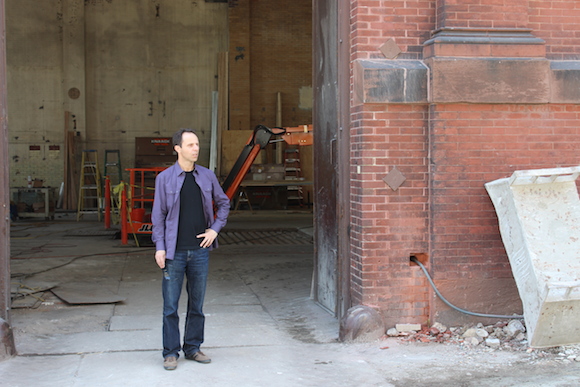The conference room is full of trash, the business entrance is covered with shoes and hats, the restaurant is still a dream, and PECO and Water Department gear is snarling progress on the patio. Still, eight months after the newly rebranded FringeArts broke ground at the 110-year-old former pumping station at Race and Columbus, there is impressive progress at the new headquarters.
Last week, Flying Kite caught up with FringeArts President and Producing Director Nick Stuccio for a tour. The facility is poised to transform not just the annual theater celebration formerly known as the Philadelphia Live Arts Festival and Philly Fringe, but the city's year-round arts landscape.
Stuccio isn't too worried about that messy conference room — at least for now. “We [had] this organization for seventeen years in one rhythm, which is this big fall festival,” he explains. “Now we have this organization doing that plus this year-round self. In a way, we're in start-up mode.”
With a budget of approximately $5.2 million for the now-completed Phase One, Stuccio says the actual cost of the remodel is about $100,000 more than expected. After a $7 million budget was announced last March, Stuccio now confirms that the cost of the whole project is likely to reach $8 million, from the $750,000 acquisition of the building to the cost of the furniture. While FringeArts missed its initial goal of opening in time for the 2013 Fringe Festival, Stuccio says they'll be ready to anchor next year's event.
The organization's fourteen staffers are already at work in a newly-fabricated second-story space, where the tops of the building's huge arched windows peek over the floors and crisp white steel beams slant high overhead. As the second and final phase of construction begins, performances are already underway in the venue's 220-seat theater (Opera Philadelphia's Svadba-Wedding closed last week).
Stuccio points to the tongue-and-groove wood paneling covering the control booth at the back of the house. The wood was salvaged from the original building's offices, where a rehearsal studio now stands, and that's not the only material they're reusing. Early 20th-century water pumps the size of freight trains gave way to smaller electric pumps in the 1950s, but even those machines weighed a few tons. A lot of that machinery is in storage following the massive renovation, and Stuccio hopes some of it will be repurposed as design elements at the eventual onsite bar and restaurant.
“They had all these really cool electrical panels and cabinets that today would be contained in a microchip,” he says. Diodes and dials, needles and gauges, lights and levers — they could one day be the backdrop for a dinner and party venue that puts a modern twist on the building's industrial past.
Right now, Stuccio can only gesture across the section of the building facing the waterfront, describing the planned kitchen, bar and restaurant, which will ultimately include mezzanine and outdoor patio seating. Conversations with an operator and designers are just beginning, but Stuccio says they hope to break ground on the restaurant (which will have its own stage) in early 2014.
The new waterfront restaurant is just one part of the broad, flexible revenue model. In fact, a lot of the building's ground floor was carefully designed to be event-friendly — and not just for arts events.
“If we do everything well and people come down here, it'll make money,” says Stuccio. That means paying attention to details like “over-built” bathrooms. That's right, ladies: FringeArts has put in extra stalls to accommodate that line at intermission.
Now operating year-round in addition to the three-week annual fall festival, FringeArts is all about presenting world-class artistic innovation from around the world, including music, theater, improvisation, dance and cross-genre works that defy description. But maintaining that mission and the costly rehab of the old building means that the organization can't rely on money from ticket sales to stay afloat. Soon, everything from weddings to daytime corporate retreats may take place here as well.
“That was a big decision. We still grapple with that,” says Stuccio of opening the building to non-arts functions in the name of fiscal stability. The building's design supports that flexibility: The main downstairs space is divided into three portions with massive, retractable, sound-proof walls.
Those walls are important, allowing total sound separation between the theater and entertainment space. For large events, those doors can slide away, the theater's stadium seating can retract, and guests can enjoy a wide open space with stunning views of the Ben Franklin Bridge.
The local theater community has been looking forward to concerts and shows at the new venue, but when FringeArts announced the ticket prices for its shows this fall, the organization faced some controversy.
The $29 tickets to Colorado native Thaddeus Phillips' 17 Border Crossings, coming up this month, might not ruffle too many feathers. But the $59 general admission ticket price (plus about $4 in fees) for the remount of Pig Iron Theatre Company's 2011 Twelfth Night, or What You Will has some locals up in arms. Upwards of $120 for one date night — not counting drinks and dinner — sounds pretty steep to a lot of Fringe fans, as Philadelphia Magazine pointed out in a recent blog post.
But Stuccio insists that presenting shows at the new building is still a “revenue-negative” proposition. In other words, the organization is not turning a profit on the work that represents its core mission, but will rely on the restaurant, event rentals and ongoing fundraising to say in business.
He also emphasizes that FringeArts planners deliberately scaled back the possible size of their theater venue, with an eye to the quality of the experience instead of profit. A different orientation of the space could have produced a 500-plus-seat theater, Stuccio explains, which would have increased revenue from shows. But FringeArts isn't for Broadway tours. The leadership team ultimately went in favor of a more intimate space, which would better serve the often-experimental work the venue presents.
Stuccio is also quick to point out that the performers FringeArts will attract are worth the price: “We want to have that message clear, that we believe it's a higher value and therefore it should be priced appropriately,” he reasons.
From getting to know their new old building, to maintaining financial stability, to figuring out the logistics of hosting events, diners and theatergoers, the new FringeArts is a work in progress.
“We're going to take this year and do our best thinking and try things,” says Stuccio. “If it doesn't work, hopefully we'll have the smarts to correct our mistakes and do better.”
ALAINA MABASO, a Philadelphia-based freelance journalist, has landed squarely in what people tell her is the worst possible career of the twenty-first century. So she makes Pennsylvania her classroom, covering everything from business to theater to toad migrations. After her editors go to bed, she blogs at http://alainamabaso.wordpress.com/. Find her on Twitter @AlainaMabaso.




